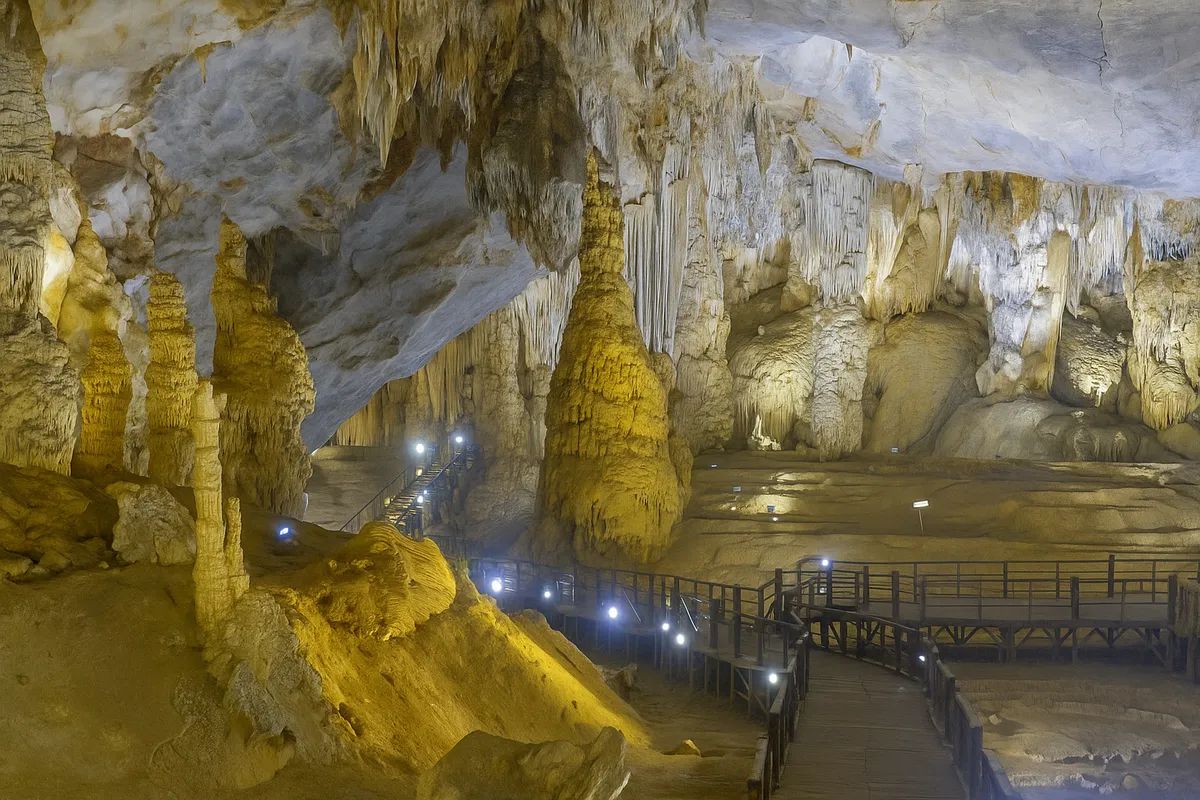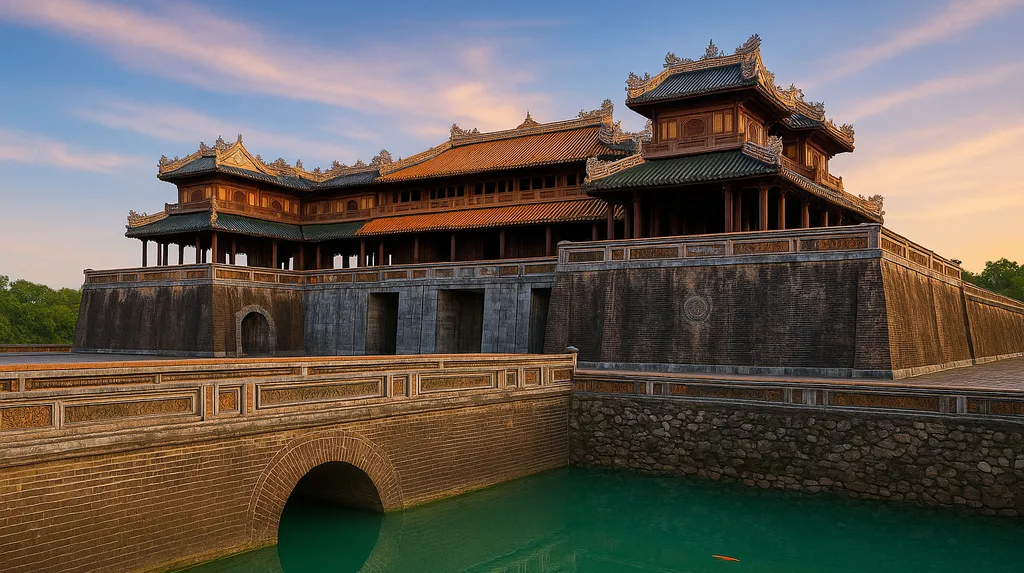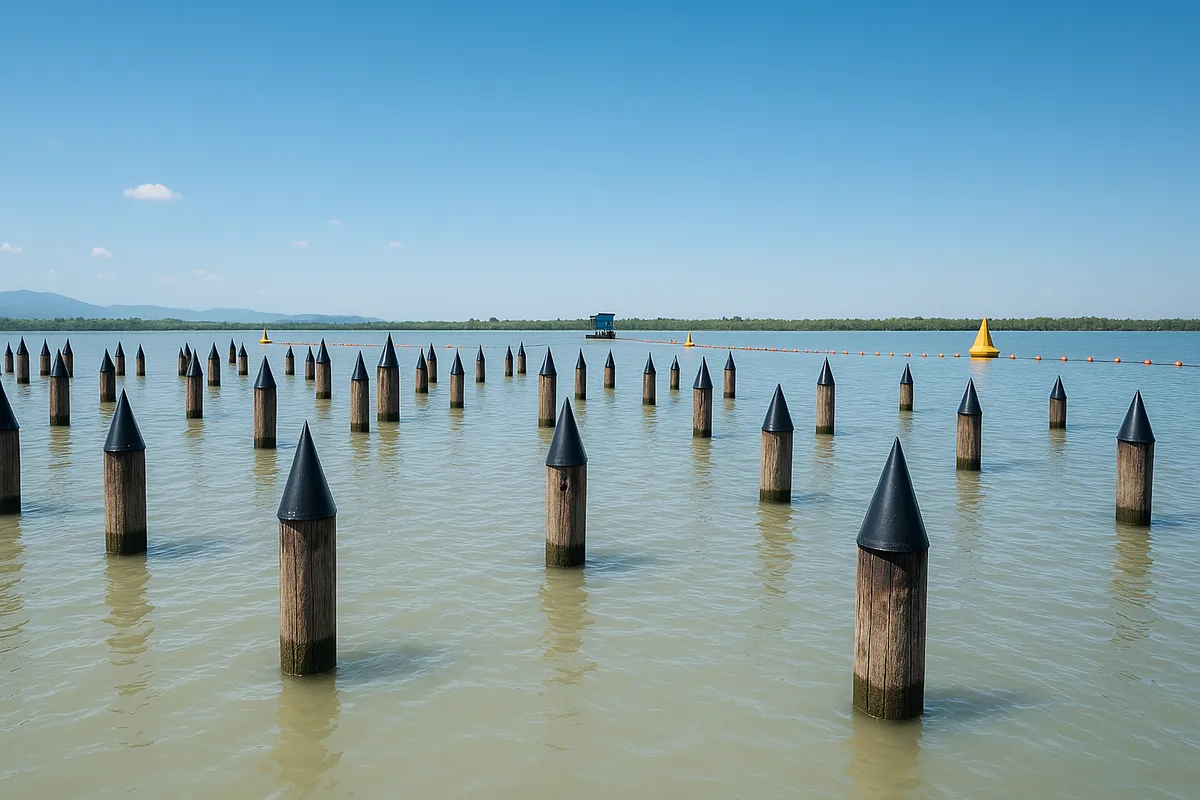Mysterious and magnificent Thien Cung Cave in the middle of Ha Long sea and sky
- Monday, Jun 16, 2025, 20:15 (GMT+7)
Mysterious and magnificent Thien Cung Cave in the middle of Ha Long sea and sky
Thien Cung Cave opens like the overture of a grand symphony of stone and light, where every ray of sunlight slipping through the cracks in the rock carries with it an ancient tale from a thousand years ago. Nestled quietly on Dau Go Island in the middle of Ha Long Bay, a UNESCO World Natural Heritage Site, it makes no noise and seeks no attention. Yet from the moment one steps through the narrow stone crevice into the heart of the mountain, a completely different world emerges, glittering, majestic, and vivid like a dream.
Inside the cave lies an expansive space nearly one hectare wide, divided into chambers that flow into each other like interconnected royal halls. The lighting is artfully arranged to highlight the ceiling and rock walls, making each stalactite seem alive, as if moving in silence. Some formations resemble dancing celestial maidens, others appear as a herd of elephants kneeling in solemn homage. In one corner, light reflects to create the image of a dragon winding through a sea of clouds turned to stone.
Since ancient times, the people living around Ha Long Bay have passed down a legend of this place as a sacred sanctuary, where the Dragon King wed Lady Cloud. The story says that for seven days and seven nights, the heavenly realm celebrated in splendor. The natural rock formations inside the cave became vivid evidence of that myth. Towering arches depict the celestial guardians, silky stalactites fall like wedding drapes, and a hidden pool mirrors the image of a fairy in her heavenly palace. At the cave’s deepest chamber lies a silent pool reflecting a spectrum of light, said to be the resting place of Lady Cloud and her hundred children.
The value of Thien Cung Cave goes beyond mythology. It is also a significant archaeological site. On its rocky walls, researchers have discovered Melania snail shells linked to the Soi Nhu culture from tens of thousands of years ago. This space once sheltered prehistoric humans, leaving behind traces of life carved into the meeting point of stone and water. Each rock here is not just a natural masterpiece, but a fossil of memory, preserving the past of an entire ancient civilization.
Strangely, the light within the cave does not remain the same. It shifts with the seasons and the time of day. At noon, when sunlight pierces diagonally through the rock at the entrance, the cave ceiling glistens with a shimmering glow. On quiet winter days when mist blankets the bay, the light becomes soft and pale like morning dew, making the space feel as if it is melting into enchantment. Few know that during low tide and under gentle sunlight, one can hear faint echoes from within the mountain, like the breath of stone still whispering through the ages.
The experience of Thien Cung Cave is not limited to vision. It reaches all the senses. A cool draft from ancient stone wafts through every gap, carrying the salt of the sea and the earthy scent of time. Every drop of water falling from the stalactites plays a note in an eternal symphony. Those who linger long enough at the cave's center will notice something curious. Even without wind, the layers of air inside subtly move with each step, as if breathing in rhythm with the visitor.
From Hanoi, the journey to Thien Cung Cave begins with a 160 kilometer trip to Ha Long City. Buses, private cars, and premium coach services provide easy access. At Tuan Chau or Bai Chay port, travelers can choose tour route number one, which includes a stop at Thien Cung Cave. Boats meander through towering stone islands and whimsical limestone formations rising from the emerald sea, composing a spectacular landscape like an ink painting. The trip lasts about four hours, just enough to soak in the serene beauty of the bay and reach the soul of this magical place.
A unique experience awaits those who visit Thien Cung Cave in winter. When the air turns crisp and the crowds thin, the cave’s beauty becomes more sacred. No more noise, no more hurried footsteps, only the breath of stone, the sound of dripping water, and the gentle light rising from the cave floor. It is the perfect moment for those who long to slow down and listen to themselves in the heart of nature.
Many travelers have spoken of a mysterious corner inside the cave where the echo is so unusual that even the faintest whisper returns like a song. Locals believe this is where the stone holds onto wishes and silent emotions that visitors unintentionally leave behind. Whether by chance or legend, that moment lingers in the heart like a refrain beyond words.
As you step out of the cave, sunlight blazes once again, and Ha Long Bay unfolds before your eyes like a curtain lifted after a dream. The journey does not end there. On the boat deck, under the soft twilight sun, the salty breeze blends with the scent of grilled squid cakes over glowing coals, creating a feeling both familiar and comforting. The meal is not merely to fill the stomach, but to extend the emotion, like a final chord in the melody echoing from the stones.
Among the hundreds of caves in Ha Long Bay, Thien Cung is neither the deepest nor the largest. But it is the one that makes people linger longer, look closer, and remember more vividly. No need for spectacle, no need for artificial illusion, the cave has the power to stir something sacred and peaceful within the human heart. Like a meeting point between earth and sky, between reality and dream, between legend and archaeology.
If one must choose a place to pause time, to rest the soul after the chaos of life, to realize that beauty may lie in a single beam of light cast upon cold stone, then that place is Thien Cung Cave. A palace with no king, no throne, no rituals, yet it compels the heart to be still, to bow gently, to awaken the senses wearied by the modern world. A place to return to nature, to origins, and to oneself.

 CHECKIN.VN
CHECKIN.VN








Share on